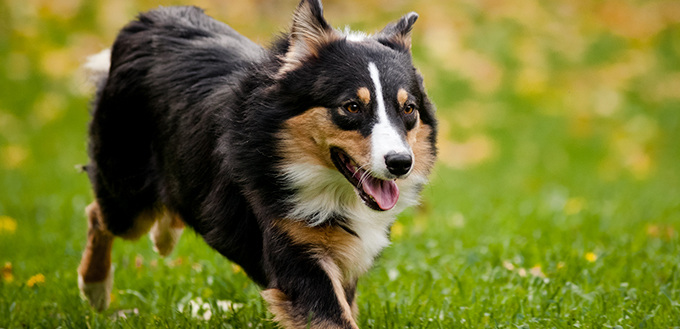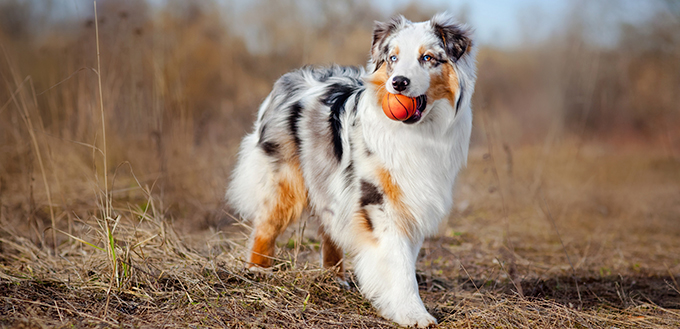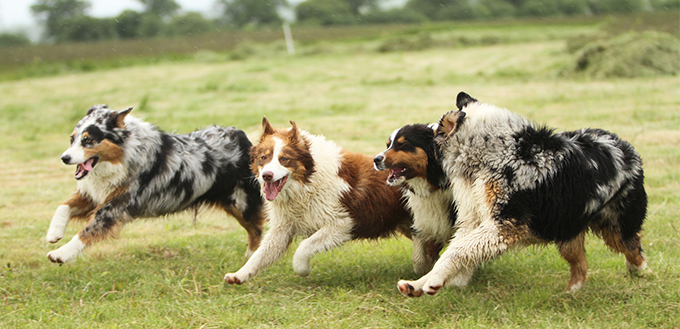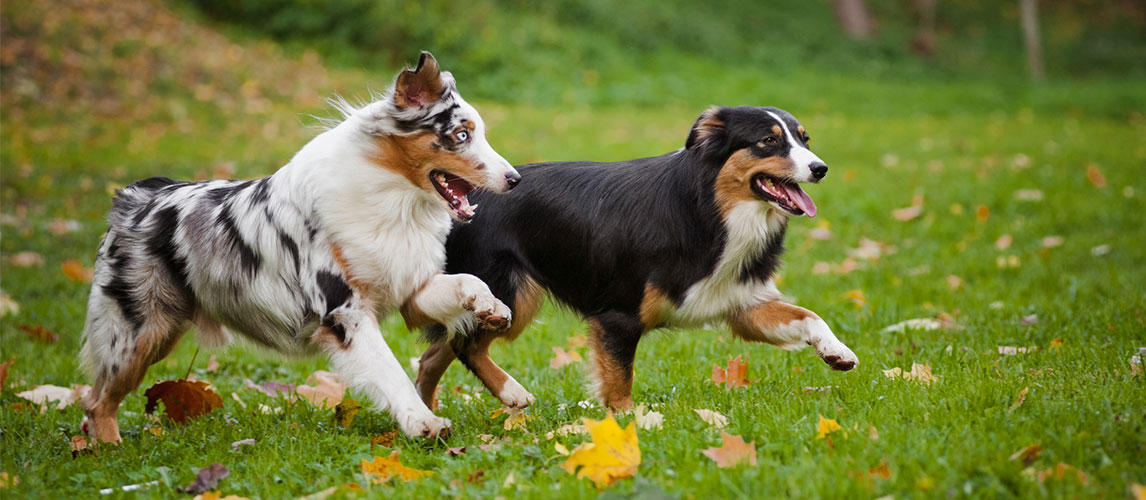Dogs are great companions to have, and it is easier to pick one that is perfect for you due to the variety that there is. To say that there is only a physical variety of dogs is an understatement as they also come with varying personalities and care requirements. If you are looking for loyalty, the Australian Shepherd scores top marks. With their affectionate nature and high levels of intelligence, these dogs are exceptionally protective over its owner. Australian Shepherds are particularly suited to owners who have great love for the outdoors. This is because they are a working breed with plenty of energy and strong instincts. Indeed, there are so much more Australian Shepherd characteristics to consider so this article will provide you with crucial information about the breed – if you are thinking about welcoming one into your home. Here are some of the key facts to help you with your decision.

History of the Australian Shepherd
The Australian Shepherd does not have a straightforward account of where they come from, mainly because of their name. There are stories that they originated from Spain, and were used as shepherds there and were then brought into America through Australia. There is proof and evidence, however, that in the 19th and 20th Centuries, the Australian Shepherd dog was developed in western North America. The Australian Shepherd dog breed, unfazed by altitude, was usually very active as sheepherders in the Rocky Mountains, and breeding attracted buyers from all over. It is debatable how related the Australian Shepherd of today is related to the dogs from Spain who were smaller and had colored coats. It is assumed that once they got to Australia, they were mixed with Australian dogs, giving them that identity. The Australian Shepherd, also known as Aussies, as we know them today, is not even recognized as coming from Australia. Their arrival in America saw the breeding of the dog to fit the American stockman’s needs. They were bred more for their traits more than their looks, and between 1940 and 1970, the Australian Shepherd Club of America began registering them.
Quick Facts About The Australian Shepherd
- They are not Australian
The origin of the “Australian” shepherd is vague, but it is clear that they are not Australian native dogs. They form part of the shepherd breeds whose origins were lost due to migration from one place to the other. The Aussie shepherd is known to come from Spain but with limited evidence. Australia is only the route that most of its owners took to get the dogs to America. There is a theory that also suggests that the name was for the sheep that were imported from Australia. The breed, as of today, is a product of American manipulation, and it has become even harder to train their lineage.
- They became famous through rodeos
Dogs, during recent years, have become great entertainers by way of rodeos and competitions, the Australian Shepherds being one of them. Granted, they were terrific herders, but they began to show up at rodeo shows very frequently, giving them some attention from their audience. Aside from their herding prowess, they performed amazing tricks, wowing those who watched, playing their way into the hearts of many. It became clear that they were a staple at rodeos and probably one of the favorites, and people will look forward to seeing them.
- They have had many nicknames
When you move around so much, you are bound to pick up a few names from different places. Aussie shepherds are one of those breeds that had a lot of names aside from Australian Shepherd. They were once called Spanish shepherds, which makes sense because of their alleged Spanish origin. At some point, they were called New Mexican Shepherd, Pastor Dog, Austrian shepherd, and Bob-tail.
- They love to work
Aussies are not only good for herding but also as seeing-eye dogs, search and rescue dogs, drug-sniffing dogs and hearing dogs. Their high energy level makes them enjoy being active which is useful in training to do other things. Their high intelligence is also responsible for their fast learning and ability to work a wide variety of jobs.
- Their tails are naturally short
Aside from being prone to heterochromia, every one of five Australian Shepards are born with a bobbed tail. The ranchers preferred these dogs, because it was safer for herding, and bred them for that purpose.

Things You Should Know About The Australian Shepherd
Training
The best way to train an Aussie shepherd is through reward and consistency. Socialization is vital for the Australian Shepherd puppy to ensure they grow to be well-mannered adults. It’s advisable to expose your 7-week old Australian Shepherd to different people, places, and dogs to give them an idea of what the real world looks like. You can still socialize the dog after the recommended seven weeks since it is better than not doing it at all. This breed does well when the training is reward-based, and so you’d have to reinforce good behavior using praise or treats to make it stick. Clicker training is another method that involves using sound to indicate the completion of the task to the dog. It starts with giving the command verbally before using the sound to signal completion. It works exceptionally well for those dogs that undergo a vigorous amount of training. Training should be a gradual process, starting with basic commands and instructions like ‘sit.’ In the beginning, you will have to establish communication with your dog, and this is probably the most challenging part of the training process. Ensure training is consistent, lasting for about 15 to 20 minutes to prevent the dog from losing interest. Play with your dog after each session so that it looks forward to the next one. Australian Shepherds are good at learning commands, and so you should teach them a wide variety of them to broaden their knowledge. For more complicated commands, break them down into parts to make them more manageable. Do not expect the dog to be obedient all the time, and make sure to put a stop to their bad behavior. Australian Shepherds are notorious herders, and you should ignore them or find some activity to channel their energy into. Do not punish your dog because there is a likelihood it might get aggressive with you. Contact a professional trainer if it gets overwhelming for you.
You may also like our article on Dog Training Clickers.
Feeding
Australian Shepherds are very active dogs that love to work, and so their diet should consist of nutritious, high-quality ingredients that can keep them healthy. They are medium-sized dogs with a solid build weighing 50 to 65 pounds for males and 30 to 45 pounds for females. The variations in age, weight, size, individual metabolism, and activity level are deciding factors on how much food you’ll feed the dog. It is recommended that an active Aussie shepherd weighing 50 pounds should consume 1353 calories daily. The Australian Shepherd puppy will consume more because it is more active and will need the extra calories. Protein should be one of the main components of the breed’s diet, preferably sourced from animals. For puppies, it is advisable to have their food containing at least 22% protein and 18% for adults. Every meal should also contain healthy fats like omega-3 and omega-6 fatty acids, which promote skin and coat development. These fats can be sourced from chicken fat or fish oil, comprising at least 8% of a puppy’s diet and 5% of the adult’s. Other nutrients the dog’s diet should include are calcium, phosphorus, and carbohydrates. Calcium and phosphorous can be sourced from dog-friendly grains and can help with the breeds’ bone and joint development. Carbs can come from sweet potatoes and peas, which have low glycemic content and will be good for the dog’s blood sugar. At all costs, avoid food with preservatives and artificial flavors and be careful before adding supplements to their diets to avoid risking their health.
Take a look at these guides on Salmon Oil for Dogs and Fish Oils for Dogs.
Grooming
To groom the dog is to invest in their wellbeing, by making sure they are always clean on the outside. It is not an easy task, but it can be a fun bonding experience for you and the dog. This breed has a double coat, which should be groomed once a week, at least. This helps to remove dead hair and distribute the natural oils evenly throughout the skin. Removing the dead, loose hair from shedding prevents matting and keeps the fur soft and silky. The tools needed include brushes, which have their teeth spaced appropriately so that your dog is not hurt. Brush in the direction of hair growth, using gentle strokes in order not to scratch the skin and finger detangle knots. Bathing the dog, using dog-friendly shampoo, will become necessary when it is visibly filthy. Dental care is also essential, and you will need to brush the dog’s teeth regularly to prevent tooth-related issues. Again, use dog-friendly toothpaste and brushes to get rid of any build-up of food that may encourage bacterial growth in their mouths. Another grooming activity is nail-clipping, which will keep your dog’s paws clean.
Check out dog toothpaste, dog toothbrush, dog nail clippers, dog grooming clippers and dog shampoo.
Health
Generally, Aussie shepherds are healthy, but throughout their life they are prone to certain conditions. Hip dysplasia is one condition where the femur does not fit into the pelvic socket. This illness is heritable and may or may not show clinical signs, and can be diagnosed via X-ray screening. The situation worsens with age, developing into arthritis, producing symptoms like pain, and in one or both hind legs. They also suffer from elbow dysplasia, another painful condition that can be fixed through surgery. Another health issue the Aussie faces is epilepsy that causes seizures. It is incurable, but with proper management, the dog will live a healthy life. The Australian Shepherd dog may also experience deafness of some form of hearing loss during their lifetime. It cannot be cured, and you will need a lot of patience and to give special dog care. Aussies are also prone to cataracts, which is a condition that affects their vision. Their eyesight becomes cloudy because of how opaque their lens becomes. Other uncommon illnesses include Collie Eye Anomaly (CEA), Distichiasis, Persistent Pupillary Membranes (PPM), Hypothyroidism, Allergies, cancer, and drug sensitivity. Having a veterinarian for the dog will come in handy in dealing with any of these issues in case they arise.
Temperament
Aussies are playful, herding dogs that often like to show dominance in the home. It is the main reason why you must socialize and train them to get rid of their unpleasant behaviors. They are very energetic and love to be busy, requiring them to exercise frequently. They are also very intelligent, fast learners, and they will give themselves some activity when they don’t get the attention and stimulation they need. It is recommended that to own this dog you have a yard in which it can run around and shed some energy. It will be unbearable to live together with this breed in a closed space like an apartment. When they are bored, they will nip at your feet or heels, and so they do not do well with children. They are however known to form powerful bonds with their owners, earning them the name “Velcro dogs.” They are also very versatile and easily adapt to new situations. They can get protective of their territory but are not considered aggressive.

To Summarize
Getting a pet can be a life-changing decision either for the better or worse, and you should make sure you are making the right decision. The Australian Shepherd temperament is such that you can live with them if you’re firm since this breed is known to be potentially stubborn. The Australian Shepherd characteristics like their size, coat, intelligence, and energy levels are some of the reasons why they became famous. To have them pets, you must be willing to devote time to cater to their needs, and only then will the favor be returned. Make sure to have a veterinarian close by for any help in taking care of the dog.
Check out our guide on Australian Shepherd Mixes – X Aussie Mutts You Will Love.
Sources:
- The Australian Shepherd, Pet Health Network
- Australian Shepherd Field Guide, PetMD
- Benoit Hedan, Coat Colour In Dogs: Identification Of The Merlelocus In The Australian Shepherd Breed, Springer






